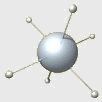Device Art is a concept for re-examining art-science-technology relationships both from a contemporary and historical perspective in order to foreground a new aspect of media art. The term "Device Art" may sound obscure, or even self-contradictory, but it is a conscious choice. The concept is a logical extension of a change in the notion of art that already started in the early 20th century with art movements such as Dada and Surrealism. More recently, interactive art has redefined forms of art and the role of artists. What we call device art is a form of media art that integrates art and technology as well as design, entertainment, and popular culture. Instead of regarding technology as a mere tool serving the art, as it is commonly seen, we propose a model in which technology is at the core of artworks. As I will discuss later, the concept took shape on the basis of an analysis of works by contemporary Japanese media artists. Features surfacing in many of these projects include interaction, a positive attitude towards technology, and playfulness. The influence of Japanese cultural tradition can be clearly traced in these haracteristics. Another aspect of this work is the artists' involvement in fields such as design, entertainment, and commercial production, which becomes evident in the approach of internationally recognized artists such as Toshio Iwai, Nobumichi Tosa (Maywa Denki), and Kazuhiko Hachiya. This approach, which is often considered suspect from a Western point of view, is actually a natural part of Japanese art. A long history of visual culture that developed independently from Western paradigms of art plays an important role in the Japanese art scene, offering artists wider possibilities for bringing their concepts outside of the context of museums and galleries.
While theoretical analysis is an important part of the Device Art project, producing artworks according to its concept is the key element. The project launched in the fall of 2004 and has been pursued by nine artists and researchers, with a five-year grant from the Japan Science and Technology Agency, since the fall of 2005.[1] The aim of the project is not only to create "device art" but also to develop a working model for producing, exhibiting, and distributing these works, and theoretically frame them. Making these artworks accessible to a wider audience and users outside of the museums and galleries is part of our agenda. Development of hardware and software modules to support the art practice is also planned.
Figure 1. Nobumichi Tosa (Maywa Denki) with his sculptures. 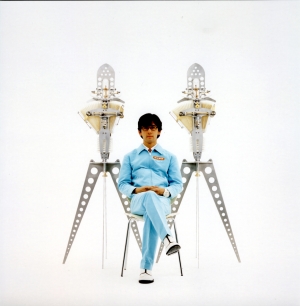 Background of the Project
Background of the Project
Japanese works have been highly visible at international competitions in the field where art and technology meet, and often involve original interface design based on proprietary hardware. Toshio Iwai, the internationally recognized media artist whose collaborative work with Ryuichi Sakamoto won the Golden Nica at Ars Electronica in 1998, is an example of an artist creating this type of work. At SIGGRAPH 2005, TENORI-ON, a prototype he developed with Yamaha, attracted much attention for its unique features and refined design. The piece consists of a matrix of illuminated touch-activated buttons that serve as both input and output mechanism. Nothing else is needed: the interface / display itself is an innovative musical / visual instrument. After having explored a similar idea for years on different platforms, including portable game machines and cell phones, the artist considers this the ultimate version. The work is a device that enables anyone to play sound and enjoy images without any learning process; it is simple, beautiful, and self-contained, with open interaction for users. As the piece is made of transparent acrylic to make the light patterns visible from any direction, its function also becomes transparent. The choice of materials is thus crucial in realizing the artist's concept.
Interest in hardware-based artwork with original design also is a key element in the activities of Maywa Denki, an "art unit" led by Nobumichi Tosa. [Fig. 1] Mixing low-tech and high-tech, he designs and manufactures strange looking robotic instruments that are performed by him or in collaboration with his "employees," or pre-programmed, or sold to enthusiastic Maywa Denki fans.[2] Although they often look odd and incorporate crazy ideas, the instruments function perfectly well. They are constructed on the basis of his knowledge and understanding of technology and material, as well as the practical skills required in cutting and molding metal parts, and working with programming chips and computers. While the instruments look strange, their mechanism is clearly visible to the audience, and Nobumichi Tosa even explains how they work during the performances. The fact that the robotic instruments occasionally do not immediately function properly also becomes part of the performance. It is important to the artist to keep the technology transparent and visible, including the possibility of its malfunctioning. Criticism of an industry that hides the "IT" behind a "wall" is an important part of his concept. With his funny robots and devices, Tosa insists that technology should not become a black box.
Figure 2. Kobito: Virtual Brownies. 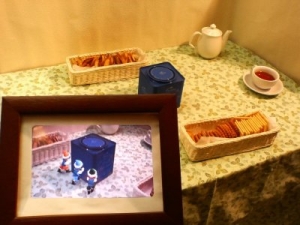 The creation of entertaining works with original, physical interface design is a field not limited to professional artists. For the past few years, SIGGRAPH's Emerging Technologies (E-Tech) and Art Gallery have been filled with Japanese art works and research projects, including numerous ones by students.[3] With approaches ranging from Hi-tech to low-tech, they have come up with original and playful ideas involving unexpected uses of technologies. At SIGGRAPH 05, visitors could push around a tea can on a table and simultaneously see on a screen how little virtual creatures, Kobitos, performed the visitors' action [Fig. 2]; or suck different kinds of virtual food and drink through a plastic straw, while the actual pressure, vibration, and sound produced by drinking would be simulated by the system.[4] [Fig. 3] At SIGGRAPH06, participants could touch a soap bubble, with images projected on its surface, which would produce sound when it broke upon touch.[5] [Fig. 4] Or they could chase the shadows of invisible goblins, suck them up with a vacuum cleaner, and feel their weight.[6] As these examples show, a combination of interaction, application of physical material and custom-made devices, as well as playfulness characterizes many of these works from Japan, be they meant as art or research. An affirmative attitude towards technology is another crucial feature of these projects. Technology is not treated as something that should remain hidden behind an artistic concept, or something that instigates fear; rather, it is an important part of these works to make visible to the audience / participants what technology has to offer. However, this does not mean that the technologies used are idealized. Even the risks accompanying technology can be represented in a playful manner, as in the case of Maywa Denki's performances and custom-made electronic instruments. The bare circuits occasionally emit sparks when the instruments are played by the artist, who comments, "Hundred volts – very dangerous!" The creation of entertaining works with original, physical interface design is a field not limited to professional artists. For the past few years, SIGGRAPH's Emerging Technologies (E-Tech) and Art Gallery have been filled with Japanese art works and research projects, including numerous ones by students.[3] With approaches ranging from Hi-tech to low-tech, they have come up with original and playful ideas involving unexpected uses of technologies. At SIGGRAPH 05, visitors could push around a tea can on a table and simultaneously see on a screen how little virtual creatures, Kobitos, performed the visitors' action [Fig. 2]; or suck different kinds of virtual food and drink through a plastic straw, while the actual pressure, vibration, and sound produced by drinking would be simulated by the system.[4] [Fig. 3] At SIGGRAPH06, participants could touch a soap bubble, with images projected on its surface, which would produce sound when it broke upon touch.[5] [Fig. 4] Or they could chase the shadows of invisible goblins, suck them up with a vacuum cleaner, and feel their weight.[6] As these examples show, a combination of interaction, application of physical material and custom-made devices, as well as playfulness characterizes many of these works from Japan, be they meant as art or research. An affirmative attitude towards technology is another crucial feature of these projects. Technology is not treated as something that should remain hidden behind an artistic concept, or something that instigates fear; rather, it is an important part of these works to make visible to the audience / participants what technology has to offer. However, this does not mean that the technologies used are idealized. Even the risks accompanying technology can be represented in a playful manner, as in the case of Maywa Denki's performances and custom-made electronic instruments. The bare circuits occasionally emit sparks when the instruments are played by the artist, who comments, "Hundred volts – very dangerous!"
Figure 3. Straw-like User Interface (SUI). 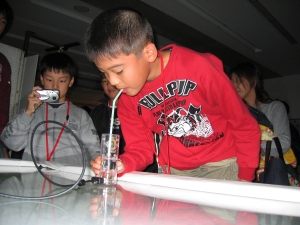 However, works that are highly appreciated in Japan are often criticized by the Western art community for their lack of seriousness. These criticisms are often related to the entertainment factor in the works and their affirmative attitude towards technology, which are both typical of Japanese works, as indicated earlier. However, being critical does not necessarily require being serious or negative towards technology. This issue is deeply rooted in each of the societies' histories, particularly the effects of the industrial revolution. However, works that are highly appreciated in Japan are often criticized by the Western art community for their lack of seriousness. These criticisms are often related to the entertainment factor in the works and their affirmative attitude towards technology, which are both typical of Japanese works, as indicated earlier. However, being critical does not necessarily require being serious or negative towards technology. This issue is deeply rooted in each of the societies' histories, particularly the effects of the industrial revolution.
In Europe and in the United States, the industrial revolution and automation are remembered as extremely negative and inhuman experiences for average people. Films such as Fritz Lang's Metropolis and Charlie Chaplin's Modern Times both illustrate this attitude. The experience certainly was different in Japan, where the industrial revolution took place much later in a short period of time in which the country was trying to catch up after more than two hundred years of isolation.[7] This also connects to the tradition of using science and technology for entertainment purposes rather than practical applications. Japan had a long period of peace until the mid-18th century when it opened its borders and the latest technologies and scientific instruments were imported and utilized for entertainment instead of "practical" purposes such as the manufacturing of weapons. Technology was something to be enjoyed rather than something to be feared.
Figure 4. Bubble Cosmos. 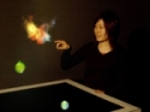 The close relationship between art, entertainment, and design, as in the case of artists creating artworks on game platforms, games themselves, or commercially available products, may also seem problematic from a Western perspective,. Toshio Iwai's TENORI-ON, which I referred to earlier, has been developed in collaboration with Yamaha. His ELECTROPLANKTON is an artwork to be played on the Nintendo DS game machine. As in the case of TENORI-ON, the software invites users to enjoy the audiovisual experiences they create.
The close relationship between art, entertainment, and design, as in the case of artists creating artworks on game platforms, games themselves, or commercially available products, may also seem problematic from a Western perspective,. Toshio Iwai's TENORI-ON, which I referred to earlier, has been developed in collaboration with Yamaha. His ELECTROPLANKTON is an artwork to be played on the Nintendo DS game machine. As in the case of TENORI-ON, the software invites users to enjoy the audiovisual experiences they create.
Games, toys, and gadgets created by artists are not very common, but they are not a rare phenomenon in Japan and are widely accepted as a part of popular culture. Bitman, for example, is "high-quality jewelry" anyone can enjoy, as its creators Maywa Denki and Ryota Kuwakubo claim.[8]
Figure 5. Maywa Denki and Ryota Kuwakubo, Bitman. 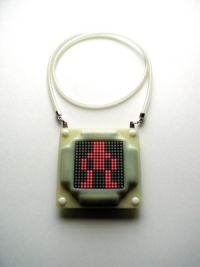 The 7cm x 7cm white plastic frame with an 8x8 matrix of red LEDs displays the pixeled image of a man, a figure familiar from early games. [Fig. 5] Hung with a chain around one's neck, the bitmap image shows a real time animation of Bitman trying to keep his balance in the swinging world. By shaking the "jewelry" one can make Bitman dance.ix The movement of the digital bitmap character is created in real time as the embedded sensors detect acceleration and tilting of the panel. The product is commercially available along with other goods developed by the artists. The distributor of the piece is Yoshimoto Kogyo Inc., the king of Japan's entertainment business, which hires most of the standup comedians appearing on Japanese TV. Nobumichi Tosa himself (who leads Maywa Denki as its "CEO") is officially an employee of Yoshimoto, although he recently separated some of his activities from the company. The 7cm x 7cm white plastic frame with an 8x8 matrix of red LEDs displays the pixeled image of a man, a figure familiar from early games. [Fig. 5] Hung with a chain around one's neck, the bitmap image shows a real time animation of Bitman trying to keep his balance in the swinging world. By shaking the "jewelry" one can make Bitman dance.ix The movement of the digital bitmap character is created in real time as the embedded sensors detect acceleration and tilting of the panel. The product is commercially available along with other goods developed by the artists. The distributor of the piece is Yoshimoto Kogyo Inc., the king of Japan's entertainment business, which hires most of the standup comedians appearing on Japanese TV. Nobumichi Tosa himself (who leads Maywa Denki as its "CEO") is officially an employee of Yoshimoto, although he recently separated some of his activities from the company.
While Tosa, with his strong commitment to consciously crossing the border between art and entertainment, is a special case, the boundaries between art and related fields are not as rigid as in the West, because the notion of art itself is different, as is widely known. Some of the best paintings in Japanese art can be found on sliding doors and folding screens. Famous artists, such as Hokusai or Hiroshige, made woodblock prints for the public. Distinctions between notions such as fine art and applied art, or high art and low art, do not exist. These distinctions appeared and became standards in Western art history. In Japan, with its different social and cultural background, these classifications were not made. Although the Japanese art system has been westernized over the past one hundred years, there still exists a cultural tradition that encourages artists and the audience to share artistic experiences outside art venues.
Art in the Age of Digital Reproduction Technologies
There have been long discussions on how better relationships between art and technology could be established. However, traditional art paradigms are still powerful enough to make art curators and even artists hesitate when it comes to exploring what media technology may mean to art. In order to recognize the boundaries we have taken for granted, we could ask ourselves the following questions:
Could artists publish their work as software running on a popular gaming platform and still claim it to be an artwork? They probably could. To put it another way, could digital "content" that is commercially available and runs on a game platform be seen as an artwork? How about a gadget, or a machine?
Many might hesitate to answer yes. However, we have already seen examples of these projects by artists who make their works, running on game platforms, commercially available. Could we claim that they do not qualify as artworks because they exist outside of galleries and museums? (They often have been exhibited in art venues as well.) Or are they not art because they are not sold on the art market? How do we define art?
We live in a postmodern society of mass-produced objects, simulated realities, and simulacra. The aura of the original, which has been valued by the art world for so long, becomes questionable for artists coping with the reality of our society today. The situation has become even more complex since an essential feature of digital technology is to enable the production of multiple, completely identical copies.
In the beginning of the 20th century, Marcel Duchamp already turned the idea of "originality" upside down with his Fountain piece, two years after he had moved to the United States where the effects of a mass-production-based consumer society were clearly visible.
In the 1960s, Nam June Paik created video sculptures by combining TV monitors and video images that were either appropriated from regular TV programs or commissioned from younger video artists. Commercially produced TV sets and news programs became original once they had been reconfigured according to his concept and "signed" by the artist. What, then, could be the position of an artist in the age of digital reproduction technology with regard to the notion of originality, the role of an artist, or the "sublime" experience that a great piece of art is supposed to bring to its viewers?
There could be multiple answers to this question, and different approaches to recognizing projects as artworks. One possible answer would be that what qualifies a project as art has nothing to do with the uniqueness of the physical component. A work that exists in multiples, even if they are not numbered as in the case of many lithographs or "original" photographs, becomes a piece of art if it brings artistic experiences to its viewer. That brings us back to a question we had asked earlier: what is the difference between a piece of art and a commercial product, or a designed object?
These questions have not been fully answered, but cannot be avoided. Device Art is a movement aimed at openly raising these questions and proposing possible answers that make sense in the age of digital technologies.
So What Is Device Art?
The term "device" usually means an instrument that serves to achieve a certain effect as part of a process. In the case of art, the goal has traditionally been an effect that the final work has on its viewers. A device used in realizing the work is not necessarily an essential part of its content – it only plays an instrumental role in the process of production. In other words, the goal and the device used for achieving it belong to different hierarchical levels. The device serves the goal.
This has been true for most traditional art. Oil paint or brushes are not considered essential in the process of presenting and appreciating a painting, except as the tools or medium utilized for its creation.
However, this no longer remains true when it comes to art forms such as interactive installations. The choice of technology has a significant impact on the theme and concept of media art for several reasons. Artists might use media technology in order to express their thoughts on the social / political / cultural ramifications of the technology. The experience provided by an artwork also depends on the technology used. In the case of interactive art, visitors / users touch and manipulate the artwork instead of contemplating a static painting on the wall. Devices are often involved in the experience of an artwork.
As a concept, Device Art is rooted in the analysis of the key role that devices play in certain types of art, that is, artworks involving hardware (a device) specifically designed to realize the artistic concept. The device itself can become the content. Technology is not hidden, its function is visible and easy to understand, while it still brings about a sense of wonder. Well designed interfaces made of the right materials facilitate interaction for users, often in a playful manner.
To summarize, a device could be the "body" of an artwork that offers an artistic experience to its users / participants. In other words, the "resulting" experience cannot be separated from the device specifically designed or chosen to enable this experience. Producing multiple copies of such work and distributing it as a commercial product makes it accessible to a wider audience, provided the piece is designed in such a manner that anyone could use and enjoy it. An artist's concept could become a part of people's lives, rather than being kept in museums and galleries. Why not share art with more people?
Interestingly enough, these ideas sound familiar to the Japanese. Cultural traditions such as the tea ceremony, flower arrangements etc. are based on this understanding. It is obvious that the goal of a tea ceremony is not to just enjoy a cup of tea. The importance lies in the whole experience, including the process and the devices used, such as teaspoons and bowls. These tools are functional and made of appropriate materials, and yet there is something more to them than just usefulness. We know that refined tools can make one's life easier. They also serve as a medium in communicating with others. In a tea ceremony, correctly chosen devices change the whole experience.
This could also be applied to art. It is problematic to separate devices from experiences if the experience is only possible through the use of devices consciously chosen for their purpose. This obviously does not only hold true for Japanese media art, but the underlying idea is already part of Japanese culture.
Conclusion
The role that media art plays in art history has not been thoroughly explored, and questions raised by people such as Walter Benjamin, Jean Baudrillard, Marcel Duchamp and Nam June Paik have not been fully answered in a media art context. Fluxus and Neo-Dada artists used Xerox machines to investigate what multiple copies might mean to art, but we have not yet found a coherent art paradigm for capturing the impact of the age of digital reproduction technologies.
Device Art is a concept that pushes the boundaries of media art and inherits the legacy of the experiments artists have been conducting with media technologies. By raising questions regarding possible relationships between art and technology, the role of hardware-based devices, and the borders between art and its related fields, and creating a common ground for artists and engineers to work together as equals, we might find some answers with regard to future directions rather than the past.
We are hoping that Device Art could bring an alternative point of view to art history. We use Japanese art history and visual culture for reference in order toilluminate our approach and how the above-mentioned questions relate to each other. However, what we find in the end might be a global model. Japanese art history just happened to provide a background that allowed artists to think differently.
Media art is a more recent development in art. Device art tries to push media even further. By doing so, it might help to gain a better understanding of the meaning and role of art in a media society.
Machiko Kusahara
Waseda University
1-104 Totsukamachi
Shinjuku-ku
Tokyo, 169-8050, JAPAN
http://www.waseda.jp/top/index-e.html
References:
[1] The project members are Hiroo Iwata (Tsukuba University, researcher in engineering), Kazuhiko Hachiya (artist), Masahiko Inami (University of Electro-Communication, researcher in engineering), Sachiko Kodama (University of Electro-Communication, artist), Ryota Kuwakubo (artist), Taro Maeda (NTT Research Laboratories, researcher in engineering), Nobunichi Tosa (Maywa Denki, artist), Hiroaki Yano (Tsukuba University, researcher in engineering), Machiko Kusahara (Waseda University, media art researcher). All the members have exhibited their works either at SIGGRAPH or Ars Electronica, or both. More information is available at http://www.deviceart.org.
[2] Maywa Denki literally means Maywa Electric Company. The unit adopts the organizational structure of a typical small-scale company that produces electric devices. The artist plays the role of the CEO while student interns and collaborating artists are called "employees." They all wear uniforms and sing the "corporate song" as a part of their performance. The robotic instruments and other works are referred to as "products". Some of them are in fact commercially available. The corporate structure chosen by the artist functions as commentary on Japanese society.
[3] TENORI-ON was exhibited at SIGGRAPH 2005, and Iwai's MORPHOVISION, developed with the NHK Research Laboratory, was selected for SIGGRAPH 2006.
[4] Kobito: Virtual Brownies (http://rogiken.org/vr/english.html), Straw-like User Interface (SUI) (http://magno.hi.mce.uec.ac.jp/~inamilab/en/projects/SUI/index.html)
[5] Bubble Cosmos (http://in5.jp/bc/english/index.html)
[6] INVISIBLE - The Shadow Chaser (http://chihara.aist-nara.ac.jp/ivrc2005/en/invisible.html) These are works that had been submitted to the Inter-College Virtual Reality Contest (IVRC), a student competition organized by the Virtual Reality Society of Japan (VRSJ) since 1993. Besides serving as a major venue for educating the next generation of artists and engineers, it has become an important meeting place for art and engineering students.
[7] It was not a complete isolation, since restricted trade was maintained with China and Holland during the time.
[8] Kuwakubo collaborated with Maywa Denki on the development of new "products." Both Tosa and Kuwakubo have exhibited internationally at venues such as NTT/ICC (InterCommunication Center) or Ars Electronica. Kuwakubo's works have been shown at SIGGRAPH as well. Tosa's performance in Paris in 2003 was a great success.
[9] http://www.maywadenki.com/mshop_english.html |
